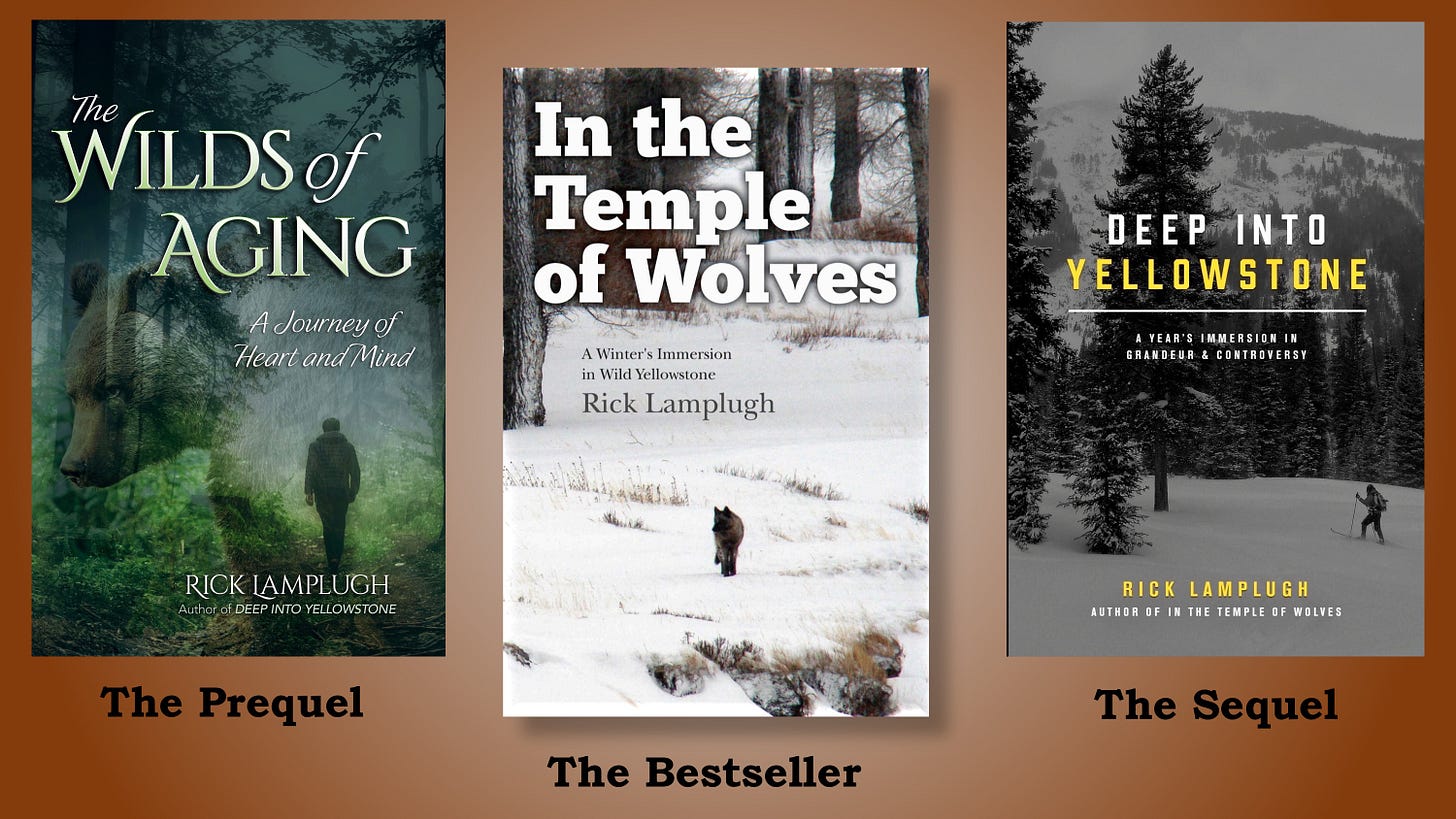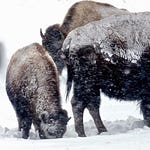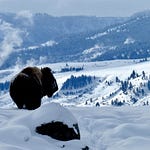After spending four consecutive days practically chained to the computer, obsessed with a writing project, I recalled that I had moved to Gardiner to experience—not just write about—Yellowstone. The next morning Mary and I escaped to a favorite cross-country skiing spot where we clicked into skis, negotiated a footbridge, and headed toward the base of a mountain. Sweat started flowing, even at ten degrees.
Just moments later when we spotted the male moose pictured above, Yellowstone’s magic took hold and started washing away those dreary days of obsessing.
We stopped to observe and appreciate the moose. He probably stands six feet tall at the shoulder and weighs a thousand pounds. He’s one of the fewer than two hundred moose that still live in the park. That’s down from about a thousand in the 1970s. In summer he devours fifty pounds of willows, other shrubs, and aquatic plants every day. But now, in winter, he can only scrounge about twelve pounds per day, though he has to keep that big body warm in temperatures that plummet way below zero. To conserve energy and increase his chance of survival, he had already shed his antlers. Though his long legs usually enable him to navigate deep snow, we watched him struggle to walk.
As the moose went his way, we went ours. Moments later we found fresh evidence of winter’s power: a dead male bison. He had taken his last walk to the base of a hill and settled into the snow. He never got up. We stood and stared in silent reverence. We saw no signs of his being attacked by a predator, and we wondered how he died. Perhaps he had depleted his reserves during last fall’s mating ritual and winter took him before he could recover. Or maybe he was injured while battling for the right to breed. Or perhaps he was just old and his time had come. However he died, this “winter-kill” had not yet been discovered by the many animals—the wolves, coyotes, eagles, ravens, magpies, to name just a few—that will survive winter by dining on him.
Leaving the bison, we solemnly side-stepped up the nearby hill. At the top, we tried to get a graceful glide going. But the snow was too deep, too soft, and we struggled like that moose had. Our poles sunk in. So did our skis. We had to yank each ski from the snow in order to move ahead in a slow, tiring, one-step-at-a-time slog.
Frustrated, we stopped to catch our breath, look around, and decide what to do. Silence buzzed in my ears. The sky was cloudless and deep blue. The snow, though dreadful for skiing, reflected diamonds.
Mary brought me out of my reverie when she said softly, “What a wonderful place. Even if the skiing is tough.”
I nodded, watched her breath steam away above her head, and said, “I’m glad we came and I’m thankful to be here. But I think I’m ready to head back.”
Mary smiled agreement and we turned around. We trudged back to the hill and side stepped down. At the bottom, the snow was a little more accomodating and we could actually ski. When we skied past the bison, I offered him a silent nod and a wish that his passing had been painless. Farther along we spotted the moose in the distance. Now sheltered under some conifers, he had bedded down in the snow and was, I hoped, just resting, conserving valuable energy.
As we continued on, I lost myself in the rhythm of skiing. I slipped deeper into the magic of Yellowstone and found myself contemplating the connection between life and death in this wild land.
If that moose survives the winter, he will start to regain strength and weight in the spring as he eats the tender new shoots, the new life, of willows. As the days warm and pass his antlers will grow bit by bit. By fall’s mating season, with his full antlers and experience he may win the right to breed with a female and help create a calf, a new life. That calf may survive or it may become a meal for wolves, a grizzly, or a mountain lion and their young. If so, that calf will foster the survival and fuel the growth of many other animals, just as the that winter-killed bison will. In this wild land, life—and death—feed life.
Thanks for joining me in this Love the Wild!
If you enjoyed this podcast, please share it with others.
If you haven’t yet subscribed, I hope you’ll do so. It’s free.
You’ll receive a Love the Wild letter in your inbox each week. In addition to podcasts such as this one, you’ll enjoy a variety of stories, slideshows, photo essays, commentaries, excerpts from my books and more. With each, I hope to warm your heart and excite your mind as we share moments with wildlife and in wild lands.
I love reading your thoughts and reactions.
I write and photograph to protect wildlife and preserve wild lands.
My bestselling In the Temple of Wolves; its sequel, Deep into Yellowstone; and its prequel, The Wilds of Aging are available signed. My books are also available on Amazon unsigned or as eBook or audiobook.












Share this post